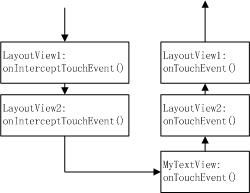Android事件触发机制
Android事件触发机制
首先,这篇文章仅仅针对于由于触摸(Touch)而触发的事件。
Android的事件:onClick, onScroll, onFling等等,都是由许多个Touch组成的。其中Touch的第一个状态肯定是ACTION_DOWN, 表示按下了屏幕。之后,touch将会有后续事件,可能是:
-
ACTION_MOVE //表示为移动手势
-
ACTION_UP //表示为离开屏幕
-
ACTION_CANCEL //表示取消手势,不会由用户产生,而是由程序产生的
一个Action_DOWN, n个ACTION_MOVE, 1个ACTION_UP,就构成了Android中众多的事件。
在Android中,有一类控件是中还可以包含其他的子控件,这类控件是继承于ViewGroup类,例如:ListView, Gallery, GridView。
还有一类控件是不能再包含子控件,例如:TextView。
本文的主要讨论对象就是ViewGroup类的控件嵌套时事件触发情况。
对于ViewGroup类的控件,有一个很重要的方法,就是onInterceptTouchEvent(),用于处理事件并改变事件的传递方向,它的返回值是一个布尔值,决定了Touch事件是否要向它包含的子View继续传递,这个方法是从父View向子View传递。
而方法onTouchEvent(),用于接收事件并处理,它的返回值也是一个布尔值,决定了事件及后续事件是否继续向上传递,这个方法是从子View向父View传递。
touch事件在 onInterceptTouchEvent()和onTouchEvent以及各个childView间的传递机制完全取决于onInterceptTouchEvent()和onTouchEvent()的返回值。返回值为true表示事件被正确接收和处理了,返回值为false表示事件没有被处理,将继续传递下去。
ACTION_DOWN事件会传到某个ViewGroup类的onInterceptTouchEvent,如果返回false,则DOWN事件继续向子ViewGroup类的onInterceptTouchEvent传递,如果子View不是ViewGroup类的控件,则传递给它的onTouchEvent。
如果onInterceptTouchEvent返回了true,则DOWN事件传递给它的onTouchEvent,不再继续传递,并且之后的后续事件也都传递给它的onTouchEvent。
如果某View的onTouchEvent返回了false,则DOWN事件继续向其父ViewGroup类的onTouchEvent传递;如果返回了true,则后续事件会直接传递给其onTouchEvent继续处理。(后续事件只会传递给对于必要事件ACTION_DOWN返回了true的onTouchEvent)
总结一下就是:onInterceptTouchEvent可以接受到所有的Touch事件,而onTouchEvent则不一定。
转自:http://www.cnblogs.com/kingcent/archive/2011/03/08/1977059.html
MotionEvent事件在onInterceptTouchEvent()、onTouchEvent()中的传递顺序
onInterceptTouchEvent()用于处理事件并改变事件的传递方向。处理事件这个不用说了,你在函数内部编写代码处理就可以了。而决定传递方向的是返回值,返回为false时事件会传递给子控件的onInterceptTouchEvent();返回值为true时事件会传递给当前控件的onTouchEvent(),而不在传递给子控件,这就是所谓的Intercept(截断)。
onTouchEvent() 用于处理事件,返回值决定当前控件是否消费(consume)了这个事件。可能你要问是否消费了又区别吗,反正我已经针对事件编写了处理代码?答案是有区别!比如ACTION_MOVE或者ACTION_UP发生的前提是一定曾经发生了ACTION_DOWN,如果你没有消费ACTION_DOWN,那么系统会认为ACTION_DOWN没有发生过,所以ACTION_MOVE或者ACTION_UP就不能被捕获。
本文源地址:http://www.cnblogs.com/rocky_yi/archive/2011/01/21/1941522.html# ,转载请注明出处!
< com.touchstudy.LayoutView1 xmlns:android ="http://schemas.android.com/apk/res/android"
android:orientation ="vertical"
android:layout_width ="fill_parent"
android:layout_height ="fill_parent" >
< com.touchstudy.LayoutView2
android:orientation ="vertical"
android:layout_width ="fill_parent"
android:layout_height ="fill_parent"
android:gravity ="center" >
< com.touchstudy.MyTextView
android:layout_width ="wrap_content"
android:layout_height ="wrap_content"
android:id ="@+id/tv"
android:text ="AB"
android:textSize ="40sp"
android:textStyle ="bold"
android:background ="#FFFFFF"
android:textColor ="#0000FF" />
</ com.touchstudy.LayoutView2 >
</ com.touchstudy.LayoutView1 >
在没有重写onInterceptTouchEvent()和onTouchEvent()的情况下(他们的返回值都是false), 对上面这个布局,MotionEvent事件的传递顺序如下:
当某个控件的onInterceptTouchEvent()返回值为true时,就会发生截断,事件被传到当前控件的onTouchEvent()。如我们将LayoutView2的onInterceptTouchEvent()返回值为true,则传递流程变成:
如果我们同时将LayoutView2的onInterceptTouchEvent()和onTouchEvent()设置成true,那么LayoutView2将消费被传递的事件,同时后续事件(如跟着ACTION_DOWN的ACTION_MOVE或者ACTION_UP)会直接传给LayoutView2的onTouchEvent(),不传给其他任何控件的任何函数。同时传递给子空间一个ACTION_CANCEL事件。传递流程变成(图中没有画出ACTION_CANCEL事件):
附SDK给出的说明:
示例对应的Java代码(来自http://blog.csdn.net/ddna/archive/2010/04/11/5473293.aspx)



